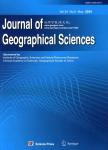The recent evolution of dune landforms and its environmental indications in the mid-latitude desert area(Hexi Corridor)
The recent evolution of dune landforms and its environmental indications in the mid-latitude desert area(Hexi Corridor)作者机构:Key Laboratory of Water Cycle and Related Land Surface ProcessesInstitute of Geographic Sciences and Natural Resources ResearchCASBeijing 100101China
出 版 物:《Journal of Geographical Sciences》 (地理学报(英文版))
年 卷 期:2022年第32卷第4期
页 面:617-644页
核心收录:
学科分类:09[农学] 0903[农学-农业资源与环境] 0705[理学-地理学]
基 金:National Natural Science Foundation of China,No.41930640,No.41771014 The Second Tibetan Plateau Scientific Expedition and Research,No.2019QZKK1003。
主 题:dune landform Gobi landform grain size sedimentology elemental geochemistry global warming desertification mid-latitude deserts
摘 要:The history of dune landform changes and dust activity at mid-latitudes is a good archive for exploring environmental changes and related landscape response.In this study,the dynamic changes,material sources,dust activity history and the influencing factors of typical sand dunes in the Hexi Corridor were comprehensively analyzed from the aspects of aeolian geomorphology,grain-size sedimentology,geochemistry and climatology.The results show that in the past half century,the typical crescent-shaped dunes and chains of crescent-shaped dunes in the study area have moved or swayed greatly,with an average speed ranging from 0.8 m/a(Dunhuang)to 6.2 m/a(Minqin).The dynamic changes of sand dunes are mainly affected by annual precipitation,annual average wind speed and annual gale days,which indicates that climate is the primary influencing factor of dune landform changes.The three-stage grain-size curve model of dune sands is obviously different from that of gobi sediments(two-stage),revealing the“immaturityof the latter in sedimentology,while the former has experienced efficiently aeolian differentiation and non-local origin.The comprehensive evidences of paleogeography,sedimentology and geochemistry reveal that the source materials of sand dunes are mainly alluvial/proluvial and palaeo-fluvial sediments,including clastic sediments in the denudation/erosion zones of the north and south piedmonts.Indicators such as the proportion of surface fine particles,the coverage of surface salt crusts,and the content of erodible sandy materials indicate that the western gobi areas are not the main source areas of wind-blown dust in the central and eastern parts of the Hexi Corridor.The spatial distribution of the movement direction of sand dunes is similar to that of the regional dominant wind direction,which indicates that the difference in the dynamic evolution of dune landforms between the east and west of the Hexi Corridor should be controlled by the regional-scale wind system,that is,controlled by the dynamic mechanism rather than the difference in material sources.The warming and humidification of the Hexi climate is a synchronous response to the global warming and the strengthening of the Asian Summer Monsoon.It is also the main reason for the reduction of dust storms in the study area,which means that a potential inverse desertification process exists in the Hexi Corridor during the same period and it is also controlled by climate change.However,the process of desertification in the oasis areas during the period is caused by groundwater fluctuation affected by human activities.



